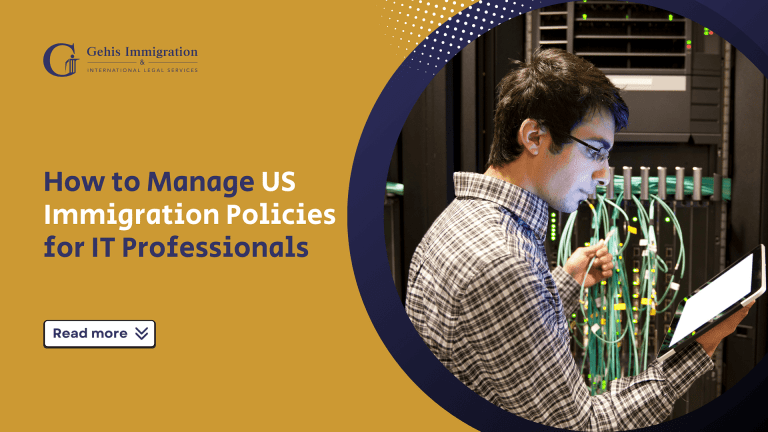The need for US Immigration Policies for IT Professionals in the United States has remained continuously strong, driven by the fast evolution of technology and the ongoing growth of the digital world. Immigrant IT workers contribute to the industry’s variety of talents, ideas, and views, driving innovation and keeping American companies competitive on a worldwide scale.
Immigration laws in the United States constantly change to reflect growing economic, political, and social considerations. The dynamic nature of these rules has a direct and significant influence on the IT industry. Changes in visa restrictions, eligibility criteria, and general immigration procedures can either help or hinder the entry of skilled IT professionals.
The capacity of IT firms to attract and retain outstanding people from around the world is inextricably related to the flexibility and inclusiveness of immigration laws. Changes in these rules can impact IT companies’ recruitment practices, altering staff diversity, project deadlines, and overall industry competitiveness.
Because the IT business relies significantly on a worldwide talent pool, changes to immigration laws can present obstacles and possibilities. This covers concerns like visa quotas, processing periods, and the availability of visa categories specifically designed for IT professionals. A full awareness of the current immigration situation is required for IT organizations and individuals wishing to deal with these details and contribute to the sector’s ongoing development and innovation.
Current US Immigration Policies for IT Professionals.
In terms of US immigration policy, numerous visa categories are particularly designed for IT workers, reflecting the importance of this sector. The H-1B visa is one of the most often used, intended for workers in specialist occupations such as IT. It enables US businesses to hire foreign workers with particular talents temporarily. Furthermore, the L-1 visa allows intracompany transfers inside multinational corporations, allowing IT specialists to work in the United States after working abroad. The O-1 visa, specifically designed for individuals with remarkable talent or success in their industry, offers a chance for highly accomplished IT experts to share their experiences.
The framework of US immigration regulations is always evolving, and recent developments have consequences for IT professionals. Changes in visa restrictions, particularly revisions to H-1B standards, have tried to promote fair compensation and prevent American workers from being displaced. Understanding these improvements is vital for organizations and IT professionals through the US Immigration Policies for IT Professionals process. Furthermore, changes in visa limitations and processing periods can substantially influence IT businesses’ ability to satisfy their personnel requirements quickly.
To get visas, IT workers must fulfill strict qualifications and follow stringent regulations. For example, H-1B visa candidates must have a bachelor’s degree or equivalent, and their work must be classified as a specialized profession. L-1 visa applicants must show their status as intracompany transferees with qualifying links between the United States and foreign firms. Individuals seeking an O-1 visa must demonstrate outstanding talent or performance in their profession, as evidenced by substantial contributions to the IT sector.
Alternative Visa Options for IT Professionals
Apart from the popular H-1B visa, there are other visa options for IT professionals with specific skills and certifications. The L-1 visa allows multinational companies to transfer IT personnel to the US, while the O-1 visa is for individuals with exceptional talent in IT. These visas offer different paths for attracting and keeping skilled workers in the growing IT field.
A thorough examination of numerous visa possibilities is essential for IT workers and organizations looking for the best route. The H-1B visa, while commonly utilized, may need help with difficulties such as yearly quotas and severe qualifying standards. In contrast, the L-1 visa gives multinational firms more flexibility, allowing them to relocate important IT staff. With its emphasis on remarkable skills, the O-1 visa provides a one-of-a-kind opportunity for highly successful IT workers. Understanding the subtleties of each choice, such as eligibility requirements, processing timelines, and potential benefits, enables more strategic and educated decision-making.
Determining the most appropriate visa category requires carefully examining individual circumstances. Educational background, job experience, and the nature of the IT profession are all important considerations when establishing eligibility and appropriateness for various visas. Employers must examine the company’s long-term goals and the specific skill set needed for their initiatives. Similarly, IT professionals should evaluate their credentials and career goals to determine the visa category best fits their unique circumstances.
Navigating legal obstacles, ensuring compliance.
IT professionals and organizations can use innovative measures to overcome legal difficulties and ensure immigration compliance. Understanding and staying current on the most recent immigration rules is important. This includes staying current on visa rule changes, processing timelines, and qualifying factors. Proactive planning, such as the early preparation of visa applications and documents, can assist in avoiding any delays and issues.
Legal counsel is important for specialists in IT visas who have extensive experience deciphering complicated legislation, predicting potential obstacles, and providing specialized solutions. Their responsibility goes beyond application help to include strategic counsel on long-term immigration goals, ensuring compliance with changing regulations, and managing unexpected legal barriers.
Immigration attorneys help IT workers and companies understand the consequences of current policy changes, create persuasive visa applications, and ensure completion of every legal requirement. IT workers may manage hurdles more efficiently by involving legal advice in the immigration process, lowering the likelihood of delays or denials.
Final Word
Addressing immigration challenges and ensuring regulatory compliance requires a joint approach that includes strategic planning, proactive actions, and skilled legal advice. By recognizing and overcoming typical legal barriers, IT workers and companies may improve their prospects of successful immigration outcomes while contributing to the sustained development and diversity of the US Immigration Policies for IT Professionals.






